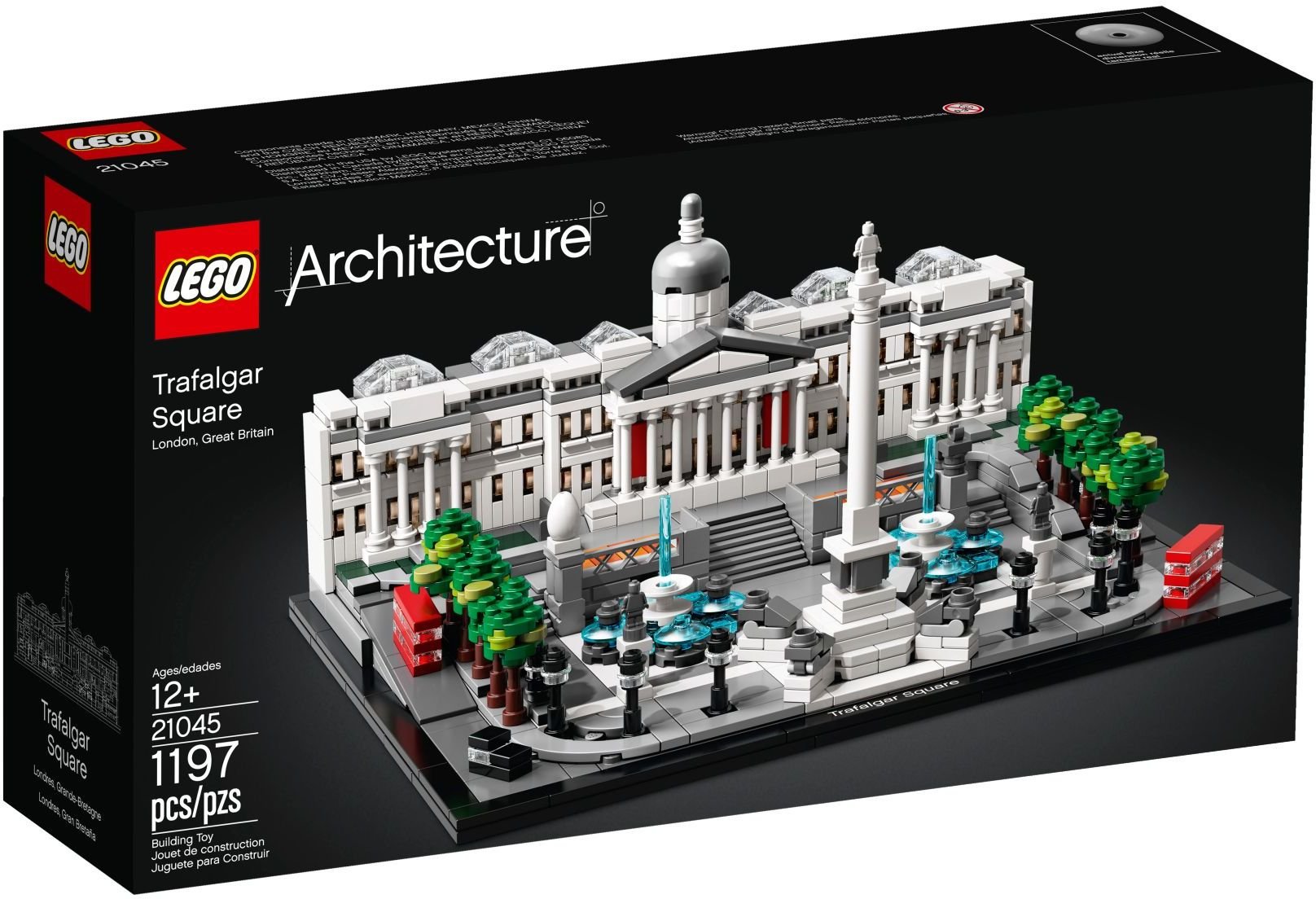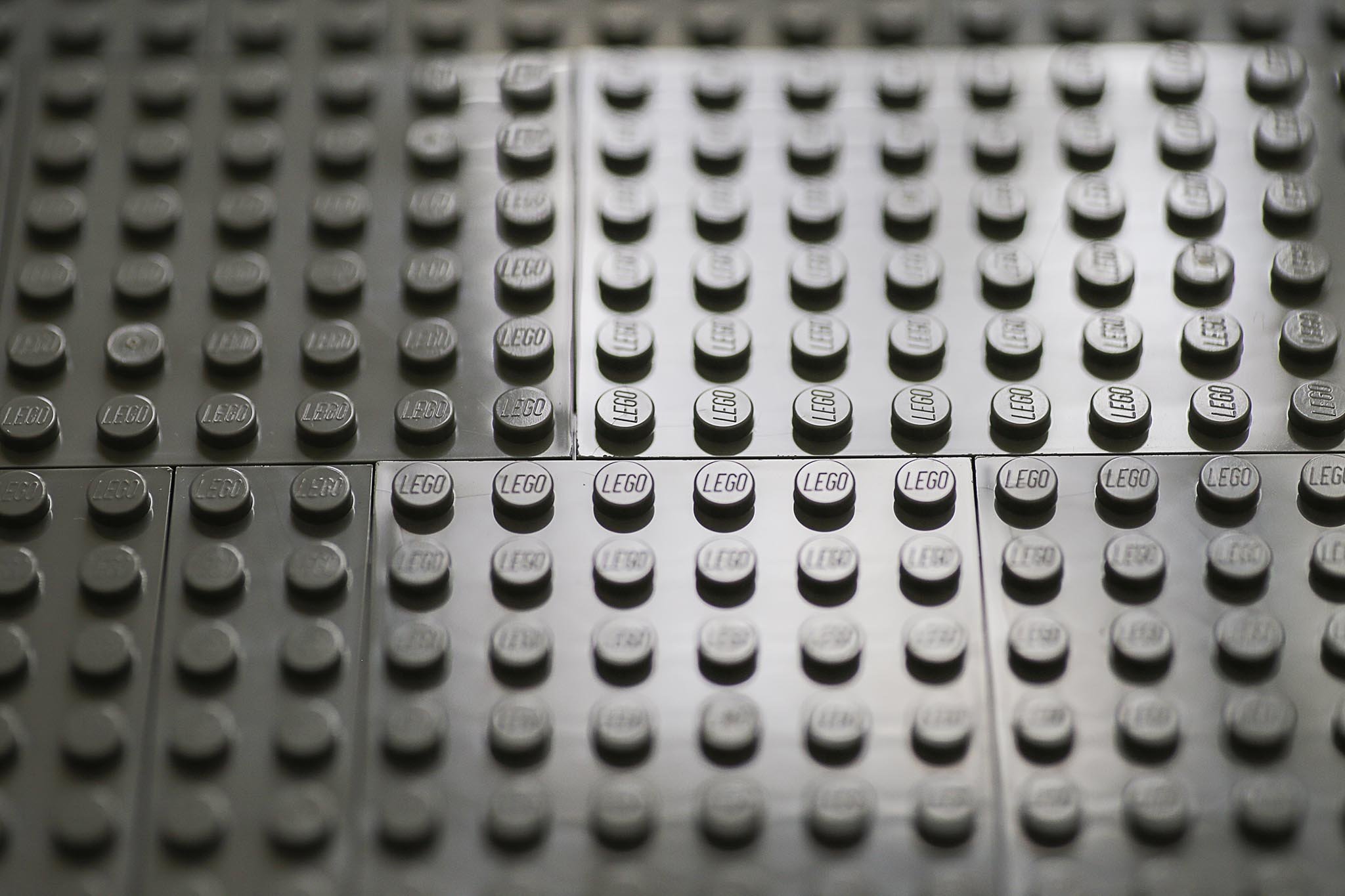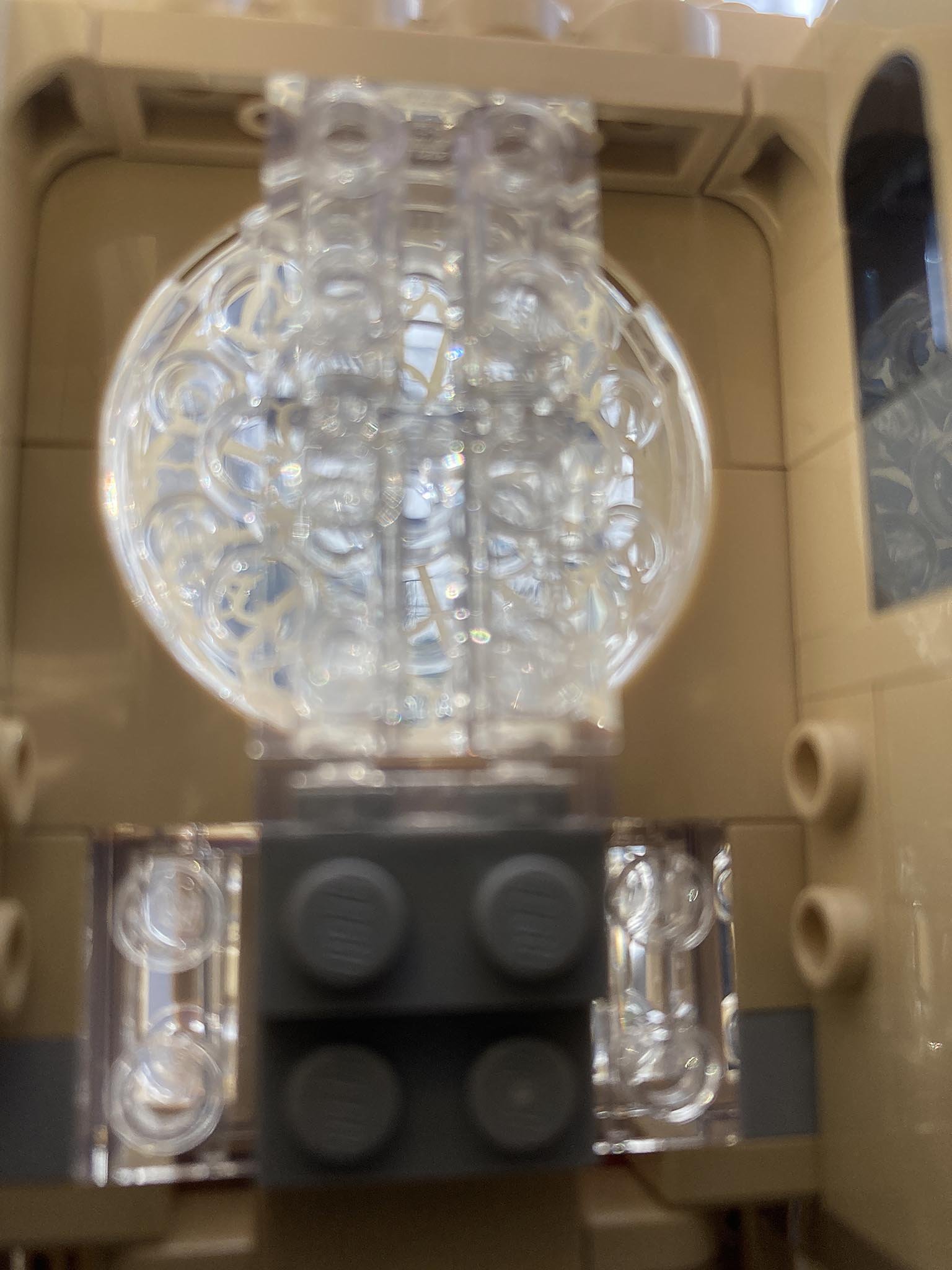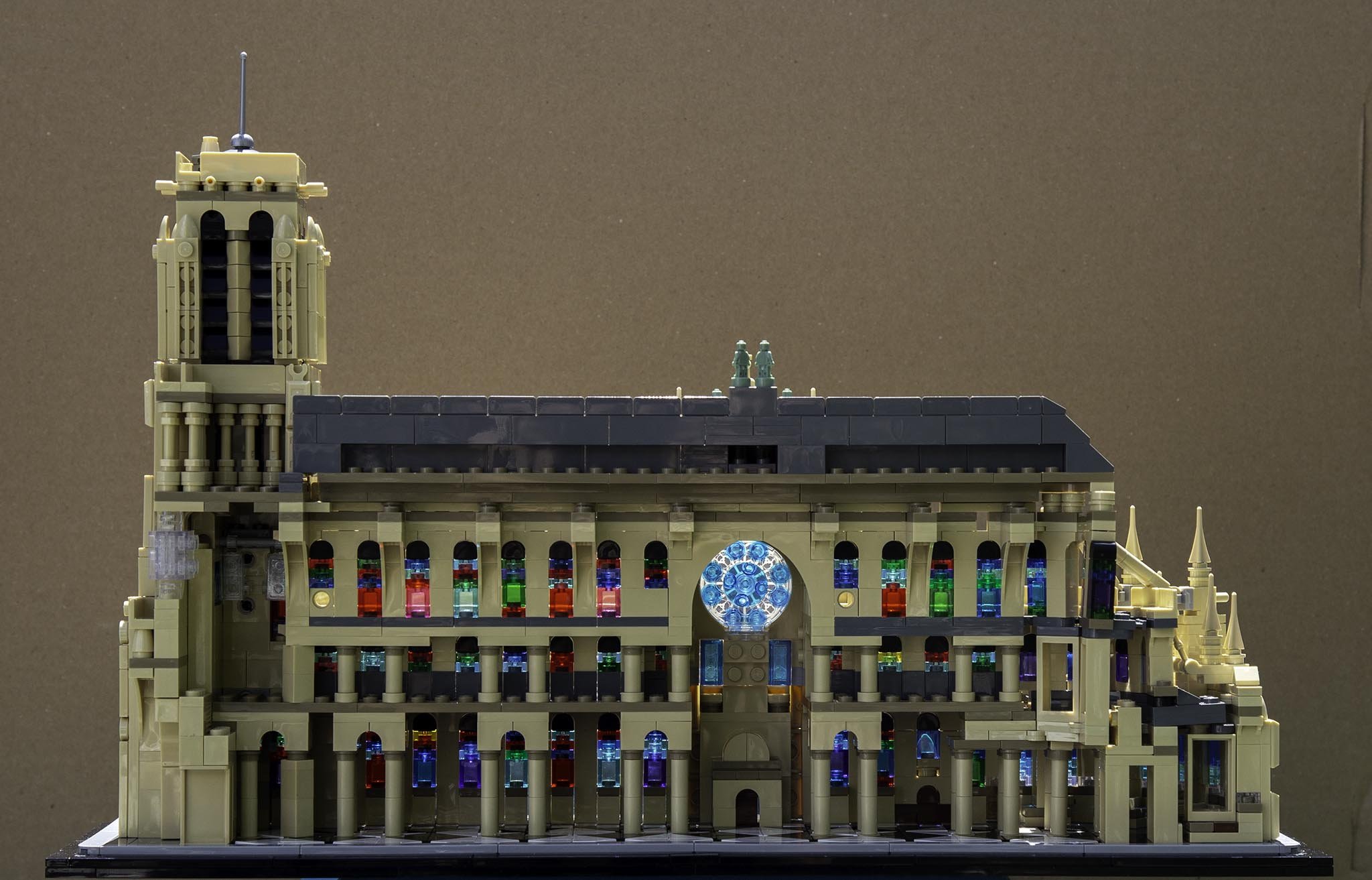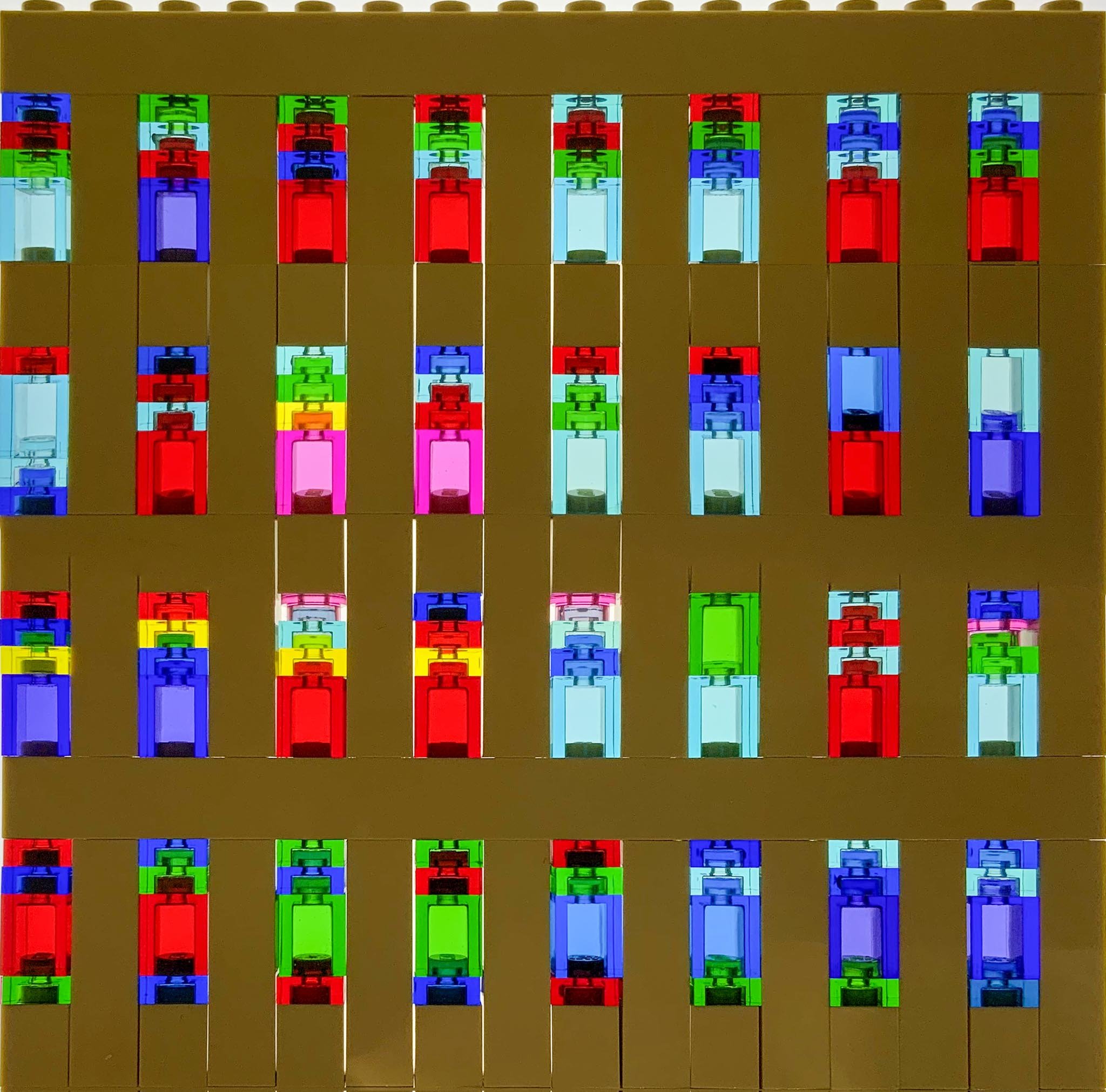Inside the Cathedral: Restoring the Stained Glass Windows of LEGO Notre Dame
/Today’s guest article comes from BrickNerd patron Wayne Tyler. We’ve featured Wayne’s architectural work many times, and today he takes a look at the LEGO Architecture 21061 Notre-Dame de Paris.
Half and Half
There are two things that really set me off when talking about LEGO architecture sets. First, I complain bitterly when an architecture set only gives you half the model. Can you say 21030 U.S. Capitol Building or 21058 Great Pyramid of Giza?
In both cases, I bought a second set so that I could have one complete model.
Second, though I own them all, the Skyline series of architecture sets strays from what attracted me to the architecture line of LEGO sets in the first place: stand-alone builds of iconic structures. Think 21005 Fallingwater or 21045 Trafalgar Square.
An architecture set doesn’t even have to be intricate or complicated. My favorite set, which is also the first architecture set I built, is the tiny 21022 Lincoln Memorial.
So when I say that 21060 Notre-Dame de Paris is THE best architecture set LEGO has produced for a long, long time, that’s extremely high praise from me. And when I say that it’s too bad that it wasn’t designed to be displayed in halves, that’s close to heresy from me. But first, let’s dive into the build.
Laying the Foundations
When the box arrived, I was surprised by how large it was. I don’t know what I was expecting, but certainly nothing this substantial (21.5 in. x 14.5 in. x 5 in. [55 cm x 37 cm x 13 cm]).
The 4,300+ pieces came in 34 clear plastic bags.
Paging through the instruction manual I was impressed and excited by the build process taken with this set. Instead of the usual ground level-up approach, the direction taken was to replicate how Notre Dame was built over the centuries. The instruction manual gives a quote from the designer: “With every bag you complete, you will see a model of a specific point in time in the construction of the cathedral, from 1163 to today. - Rok Žgalin Kobe, Senior LEGO Designer.” I’ll be including a few more quotes from him from the instructions and from an interview with BrickNerd.
Assembling the model is akin to a three-dimensional version of reading David Macaulay’s book, “Cathedral: The Story of Its Construction,” which fascinated me when it was published. As you work your way through the instruction manual, the comments become a history lesson about the building of Notre Dame. I almost flunked history when in school. Why wasn’t history taught like this?
I am primarily a MOC builder, but one reason I buy and build LEGO sets is to learn new building techniques. This set doesn’t have many new or surprising techniques, but the techniques it does use are advanced and sophisticated, and show how far LEGO designers have pushed what can be done.
The first step was, of course, to build the base. But in this case, only half of the base was assembled, not the full width. The other half wouldn’t be needed until you were 1/3 of the way through the instruction manual. This first portion focuses on the eastern part of the cathedral—the chancel or choir area—which would contain the altar (which notably is not included in the LEGO set). In real life, this approach, when finished, allows a cathedral under construction to be used as a functioning church while the rest of the building is still being worked on.
One of the things that struck me during this phase was the new pieces being used (parts that have come out within the past year or so) that allow an accuracy in the look and construction that wouldn't have been possible three years ago. (But I suppose the same could be said for any current LEGO set.)
“Build it, and it’s a nice display model, but now take it apart, and you can really build with it. It’s a good parts pack.”- Rok Žgalin Kobe. And I’ll add, especially for architectural models.
The new Tile 1x2, Deg. 45, Cut, Left & Right in black and white
A ridiculous aside here. In building this, I used Wayne’s version of Feng Shui. As much as possible, within the limits of required part orientation, each piece is placed so the LEGO logo reads left to right, near to far or bottom to top. That meant I looked at almost every part with a magnifier to make sure it was “properly” oriented. Why would I go to such lengths when assembling a set? So that the energy flow through the model would achieve harmony with its environment?
Well, maybe. But mostly because it slows me down when assembling a build so I can observe, contemplate and internalize what the designers have done and how they did it. I’m not slapping a set together quickly and possibly missing something.
The easternmost portion of Notre Dame is a half-circle using hinge plates to create the curved walls. I’m a stickler for trying to “get it perfect” so creating the appropriate uniform curve took a lot of tweaking (and retweaking almost every time I added more pieces). However, the final result was worth taking the time.
Inside and Out
After completing the chancel area, you can get a look inside of the “enclosed section.
I stuck my smartphone inside the the model and took a picture that both surprised me and showed what this model could be. I now wanted to see the inside as much as the outside.
This was the first time I’d encountered a LEGO architectural set where the construction techniques used on the interior, rather than just supporting the building’s façade, replicate the architecture used in the actual structure. To me, this was the most impressive part of this model... both the exterior and interior recreate the existing cathedral!
The next step in construction was to add the other half of the base on which the transepts, nave and towers are built.
I am not an architect, nor a church historian, so while working on this set, I had to refresh my vocabulary and learn new terms describing different parts of the cathedral... narthex, nave, transept, crossing, choir, chancel, sanctuary, apse and the like. Most of these I knew, but not in the strict architectural sense, and not how they are applied to a cathedral. The wanna-be architect in me was delighted to learn about these designations.
Working on this section became repetitious, but not as bad as 21030 U.S. Capitol Building... and nowhere close to 10276 Colosseum. The approach of building the set in sections limits the amount of repetition done at a particular time. “It provides for a better building experience because you don’t have to do something 40 times. You do something 10 times and then later, in a different part of the model, 10 more times.” - Rok Žgalin Kobe.
There’s an interesting choice for the stained glass windows, using trans-clear bricks for the bottom half and trans-black bricks for the top half, instead of colored bricks. This makes perfect sense when viewing the exterior of the model, and keeps with the subdued elegance of the set. In daylight, the windows of the actual cathedral do appear very dark when seen from the outside. However, when inside, the stained glass windows provide a spectrum of intense colors and that is lost when viewing the interior LEGO version.
Dave Schefcik, Nerd in Chief of BrickNerd, asked Rok about the stained glass windows during an interview:
Dave: What was the conversation like in terms of adding color?
Rok: Yeah, the stained glass window effect. That was more a personal preference. I’m more minimalist in how many colors I use. That was considered for a very short time, but it [using trans-black and trans-clear bricks] didn’t seem like a much more somber color scheme.
Working on this section included building the main entrance on the west side. To replicate the extremely tall and narrow doors, back-to-back “Panel 1 x 2 x 3 - Hollow Studs” are used to great effect. Also, the layering of different pieces evokes the depth of the arched gates.
However, the doors become the only place through which you can look at the inside of the cathedral from the ground floor. This view left me wanting to be able to see more. I wanted to be able to see something like this on the right!
As you build up the transepts, you add the north and south transept rose windows.
back side of the south transept rose window
The printed trans-clear “Dish 4 x 4 Inverted with Open Stud” part does a fantastic job of recreating the look of the actual rose windows! But... the construction of the rose windows does not include any colors, so the iconic look of the stained glass is missing. I wondered what it would look like with colored pieces.
As the walls of the nave were built up, the flying buttresses were added. When I was constructing these, they didn’t appear to resemble what they were meant to represent. But when all were placed and viewed from a distance, they looked remarkable. I especially liked the detail of adding the “Bar 2L with Stop Ring” to simulate the gargoyle water spouts.
The final steps were adding the towers, the roof and the spire. The completed model looks convincingly like the real thing.
As does the inside the completed cathedral.
Here are some of the details that stood out for me.

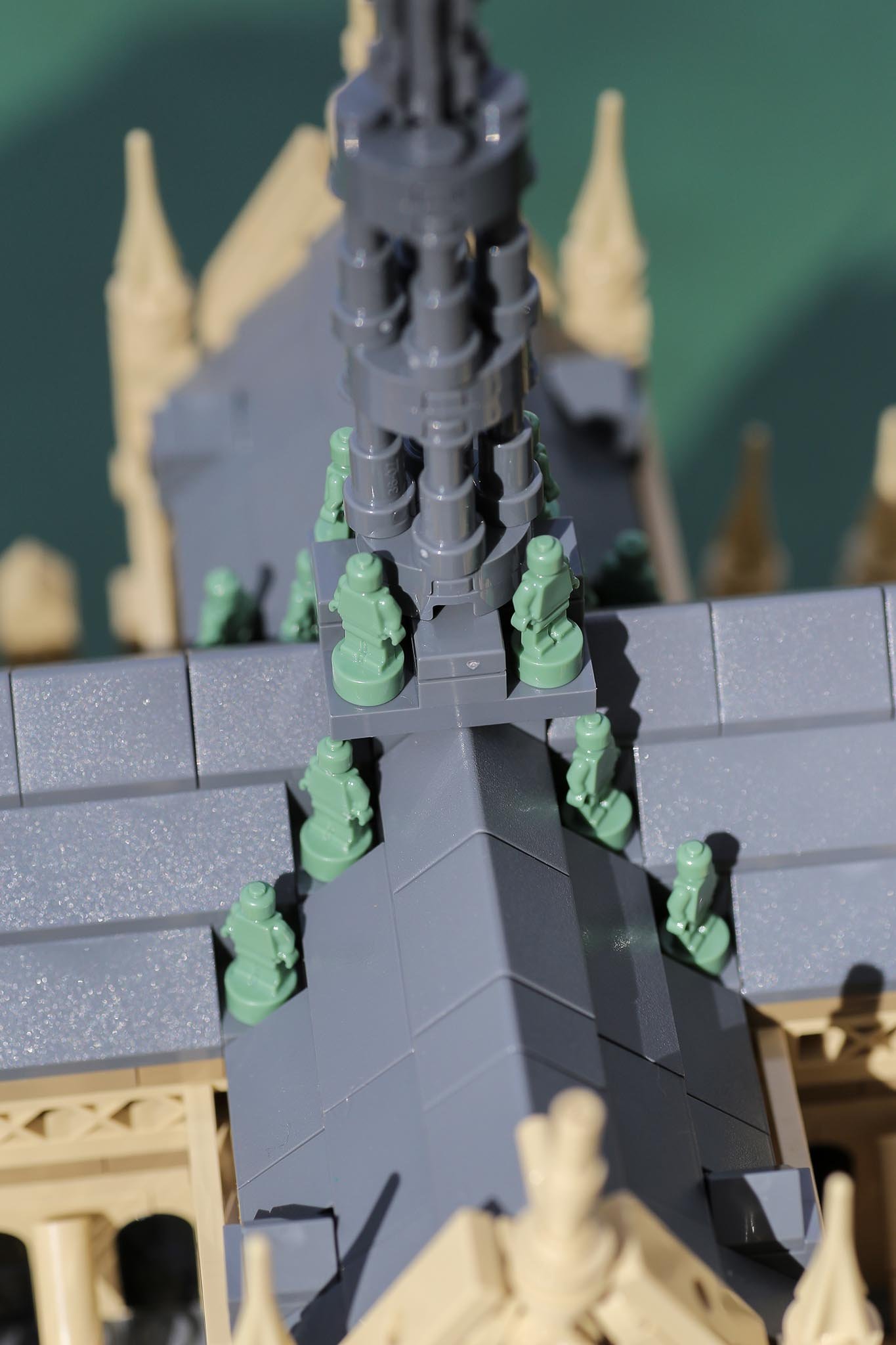
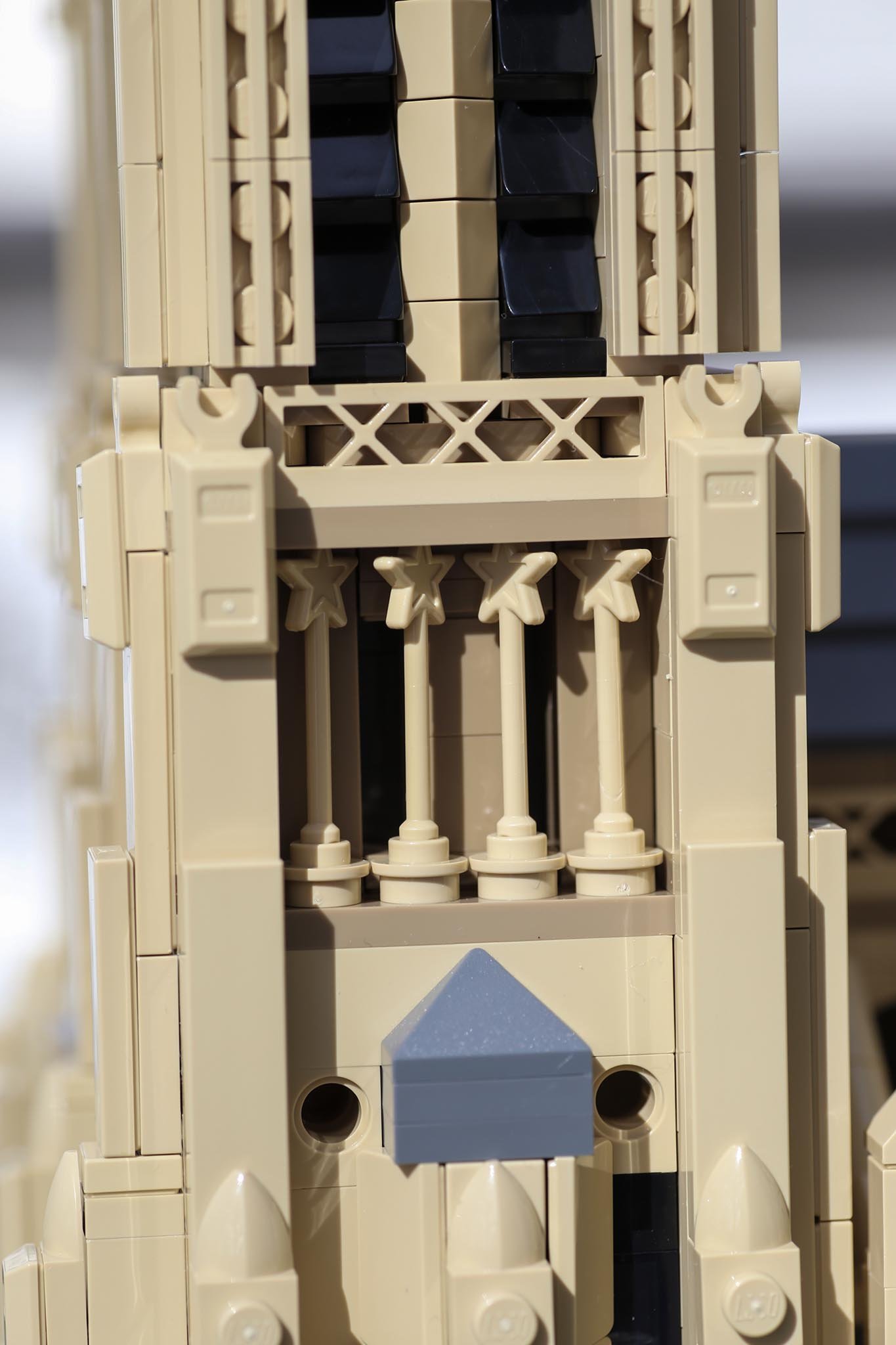
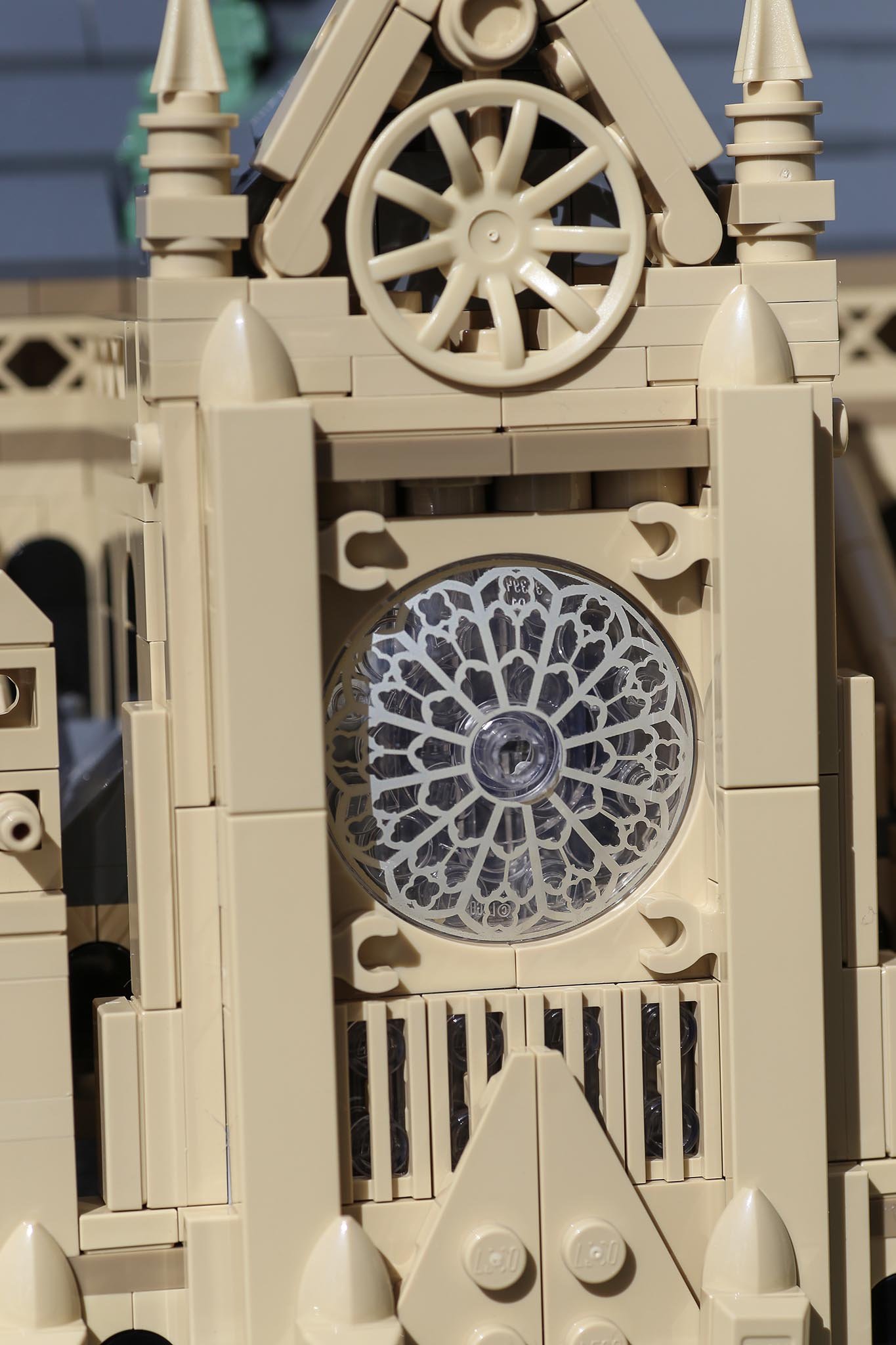
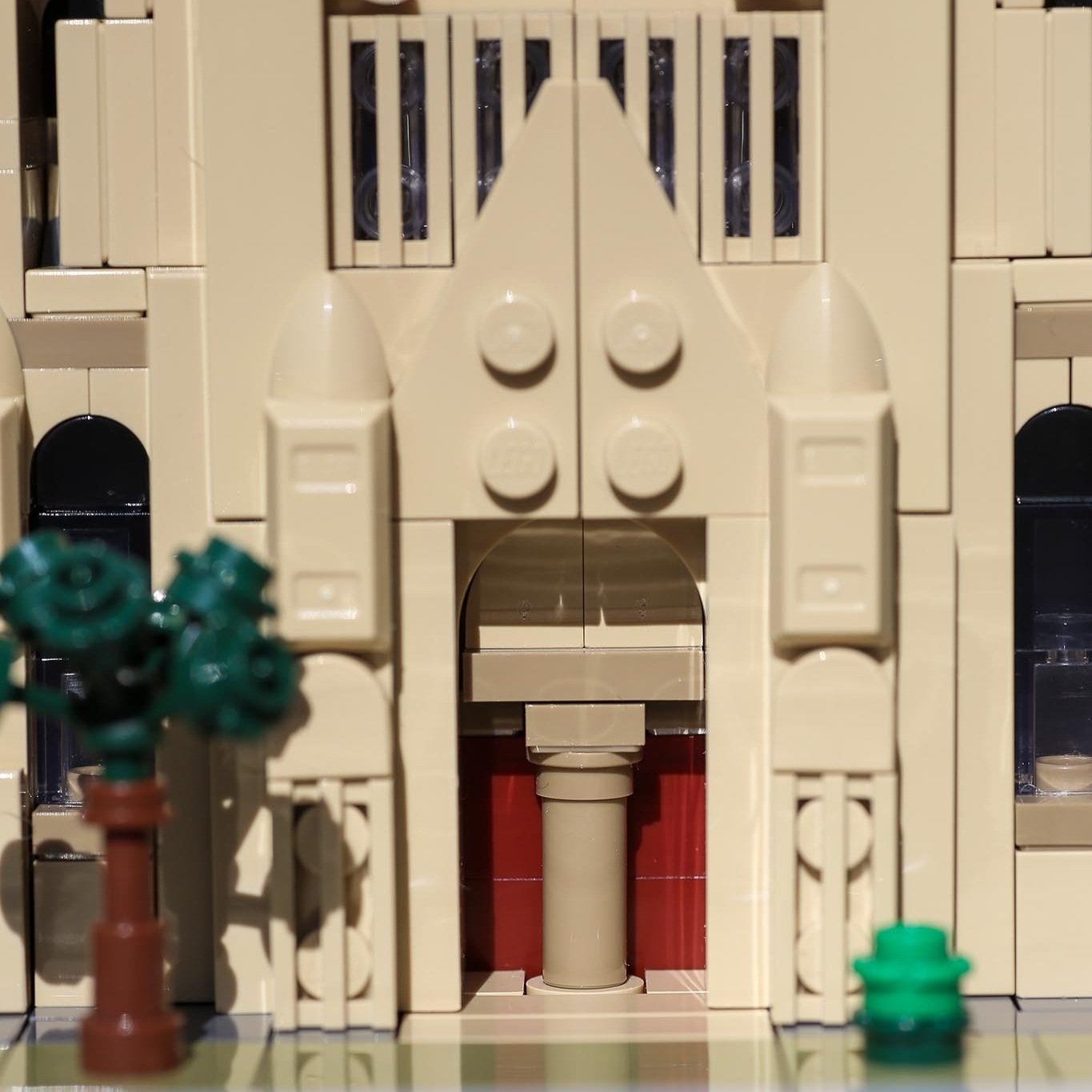
Religion vs. Architecture
Another aside here. With LEGO’s recent Terms of Service clarifications about acceptable content that fits with brand values (i.e. “topics that do not fit our brand values” per LEGO Ideas’ Product Idea Guidelines and BrickLink Studio Gallery’s display guidelines), it’s generally understood that religious-themed builds will not be accepted for submission to Ideas and will not be publicly displayed on BrickLink. Dave Schefcik asked Rok about the seeming incongruity.
Dave: What would you say to those who call out this set for being a religious building in opposition to several statements LEGO has made saying that such subjects in sets should be avoided?
Rok: I’m an artist—my personal spiritual path is beside the point. For me, Notre Dame is a masterpiece of architecture, first and foremost. This building has been through a lot. Napolean crowned himself in the building so you can argue that the French Revolution got its start there. You can try adding meanings to it, but the one thing you cannot argue about is that it is a masterpiece of architecture.
It is a cultural touchpoint and worth celebrating by building it in LEGO. The building conveys that together, we can do much more. The techniques they used building it are amazing and still awe-inspiring today. It is not easy to create such a building and certainly not cheap. You have to have serious dedication and talent to pull it off. That’s worth celebrating.
That’s what we do with LEGO architecture is celebrate the icons around us. So I don’t think the religious factor should be a detractor because in my opinion, if you go down that route, you can cancel everything. So why not celebrate the good things?
I personally visited Notre Dame in 2007. My immediate reaction and final takeaway was that the building was a magnificent piece of architecture. Sitting quietly in the nave, surrounded by religious symbols and artifacts, my overwhelming impression was not that of religion but rather it was an amazing space and volume. I marveled at the height of the interior. I was awed by how the light played within the space. I was entranced by how sound moved through the cathedral. In short, the structure itself, not the religious overtones, is what made the time spent there memorable and special. IMHO, this set honors and celebrates that.
In all, this set is an exquisitely detailed and realistic recreation of the Notre Dame Cathedral. The build process is unlike any previous LEGO architecture set, which made it an interesting and educational experience. It is the best architecture set to come out of LEGO in a long time, and, in my opinion, one of the best of all time. Though I was provided this early set by LEGO, I will definitely be buying another! Why, you ask? Well, that brings us to the part where BrickNerd goes the extra mile and gets creative…
A Slice of Sunshine
As I alluded to previously, I think this set is worth displaying for how it looks both inside and out. And, I think the design choices/limitations of not using transparent colored pieces for the stained glass windows was a major oversight. So... I want to introduce Notre Dame, Part 2.
My first inclination was to rebuild the set so that different sections would be removable. The tower section, the nave section, the transept section and the chancel section. And I still will do that... with the set I’ll buy for myself in the future.
However, due to the short timeline of putting this article together, I choose a different tactic... building exactly half the cathedral on the north side. That way you can see, side-by-side, what the inside and outside look like and see how the architectural elements relate to each other. (Yes, I railed about LEGO Architecture sets that only present half a model, then I made one myself.) I call it NoDa, since it’s half of Notre Dame.
An interesting observation in doing this was that I built it from the ground up, unlike how the instructions are organized. So while building NoDa, there was a lot of flipping back and forth in the instruction manual as work on the chancel, transepts, nave and towers occurred simultaneously. This is the first time I’ve ever had a shopworn instruction manual!
I also wanted to recreate the feeling of the stained glass windows that you can perfectly see now that the set was dissected. There was a challenge of getting some parts that were not part of the original set (transparent colors for the stained glass windows), a few exclusive parts that are not yet available from LEGO (had to be inventive with the pieces that already exist) and a few extra parts that were needed to fill in interior areas to give a more finished look. It was time to hit up LEGO’s Pick a Brick bestseller list and BrickLink!
While waiting for orders to show up, I had the in-house color consultant (my wife) put together a set of transparent color pieces based on photos of the actual stained glass windows to see what worked and what looked realistic. It was determined that a combination of bricks for the bottom half of the window and plates for the top half worked best to approach the look of Notre Dame’s real stained glass windows. Using transparent dark blues, purples, and reds, with the occasional light blue and green, gave a representative look of the stained glass windows in the cathedral.
Note, the build certainly looks stunning on the inside with this technique, though the colors are quite distracting when viewed from the outside, so i can see a bit of where the designer was coming from. Here’s a comparison photo with between the real version and my recreation.
I’m pleased with the resulting build. NoDa really shows off how well the designers replicated not only the outside but also the inside of Notre Dame. There is one more thing I wanted to include, but time and cost made it undoable... lighting the interior! But, that will have to be an article for a later time.
LEGO Architecture 21061 Notre-Dame de Paris is available for pre-order and will launch beginning June 1st for $229.99 in the US, $299.99 in Canada, and £199.99 in the United Kingdom, and $449.99 in Australia.
DISCLAIMER: This set was provided to BrickNerd by LEGO. Any opinions expressed in this article are those of the author.
What other sets should we cut in half? Let us know in the comments below!
Do you want to help BrickNerd continue publishing articles like this one? Become a top patron like Charlie Stephens, Marc & Liz Puleo, Paige Mueller, Rob Klingberg from Brickstuff, John & Joshua Hanlon from Beyond the Brick, Megan Lum, Andy Price, Lukas Kurth from StoneWars, Wayne Tyler, Monica Innis, Dan Church, and Roxanne Baxter to show your support, get early access, exclusive swag and more.




